Mental Health Analysis of Aboriginal Adolescent Brandon's Case Study
VerifiedAdded on 2022/09/22
|6
|1290
|14
Essay
AI Summary
This essay presents an analysis of the mental health challenges faced by Brandon, a 14-year-old Aboriginal adolescent, as a case study. The paper delves into Brandon's symptoms, including aggression, substance abuse (marijuana), disturbed sleep, psychotic experiences (hearing voices), and suicidal ideation. It explores the diagnostic considerations from a social worker's perspective, highlighting the impact of cultural factors, trauma, and potential psychotic disorders. The essay outlines a comprehensive approach to intervention, emphasizing the need for culturally sensitive strategies, family counseling, and engagement with the community and elders. It suggests practical solutions, such as motivational videos, interaction with elderly figures, and culturally appropriate resources to empower Brandon. The conclusion underscores the importance of addressing the root causes of his distress and providing him with support, love, and compassion to foster a positive outlook on life. References include works on Aboriginal mental health, barriers to treatment, and the importance of cultural context in interventions.
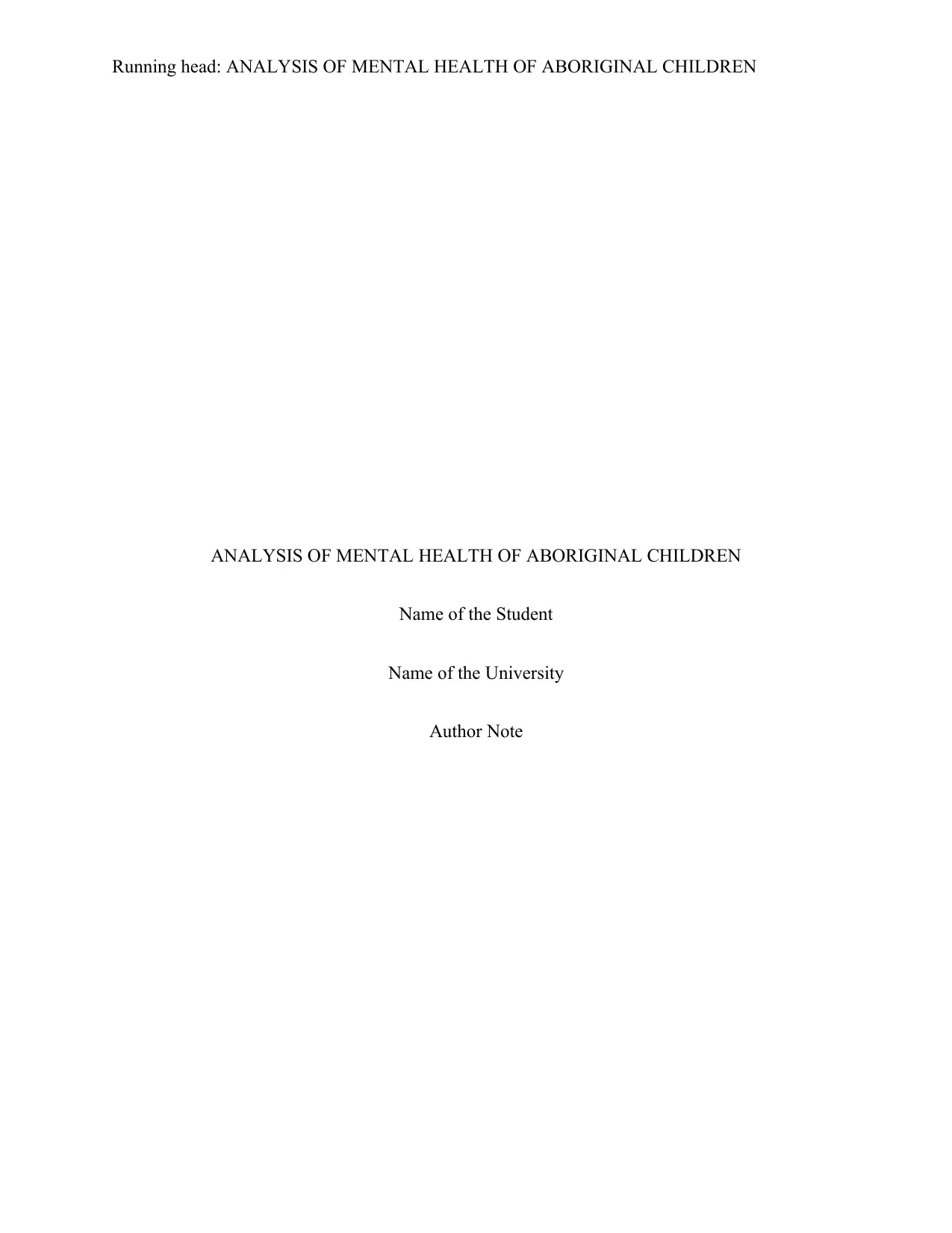
Running head: ANALYSIS OF MENTAL HEALTH OF ABORIGINAL CHILDREN
ANALYSIS OF MENTAL HEALTH OF ABORIGINAL CHILDREN
Name of the Student
Name of the University
Author Note
ANALYSIS OF MENTAL HEALTH OF ABORIGINAL CHILDREN
Name of the Student
Name of the University
Author Note
Paraphrase This Document
Need a fresh take? Get an instant paraphrase of this document with our AI Paraphraser
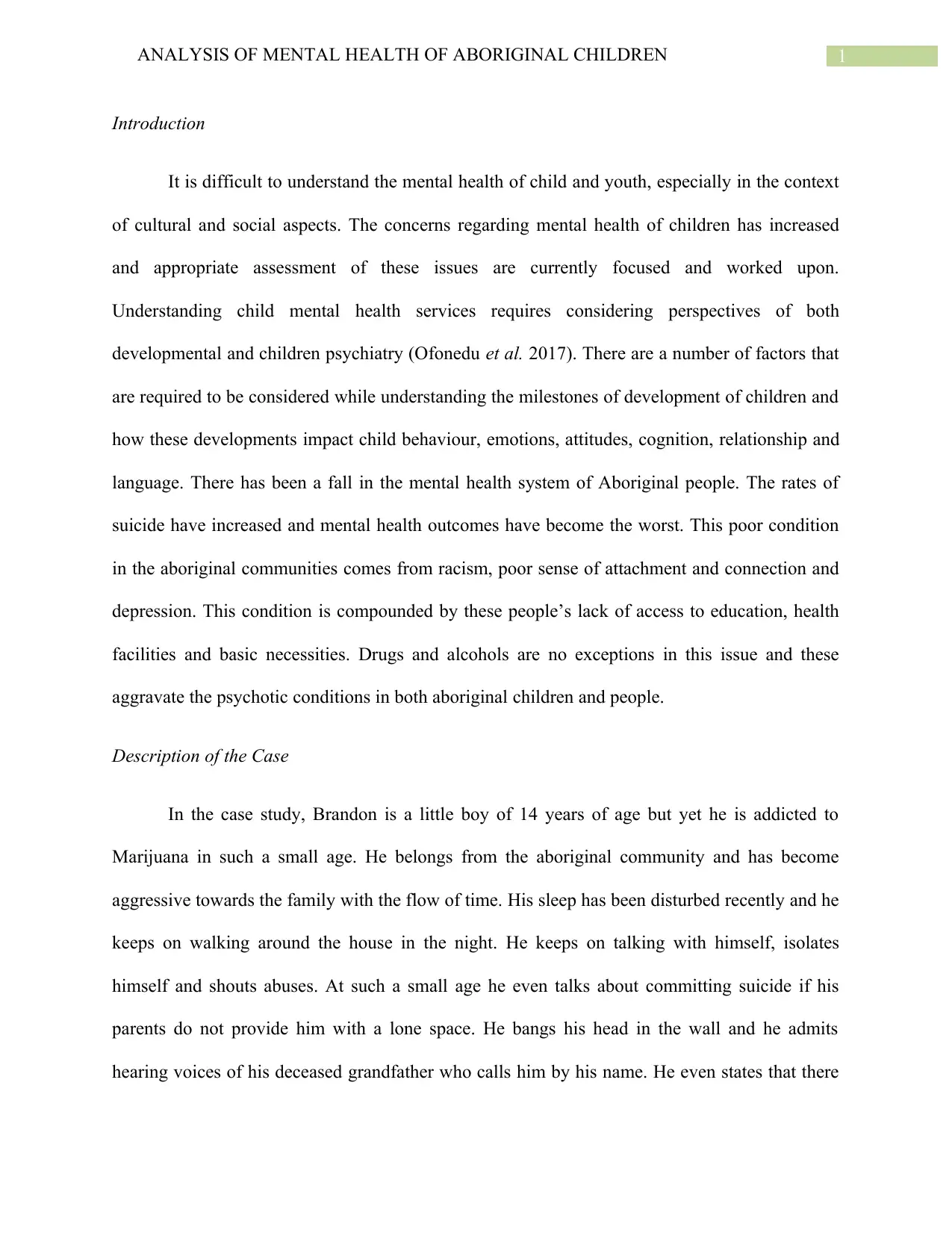
1ANALYSIS OF MENTAL HEALTH OF ABORIGINAL CHILDREN
Introduction
It is difficult to understand the mental health of child and youth, especially in the context
of cultural and social aspects. The concerns regarding mental health of children has increased
and appropriate assessment of these issues are currently focused and worked upon.
Understanding child mental health services requires considering perspectives of both
developmental and children psychiatry (Ofonedu et al. 2017). There are a number of factors that
are required to be considered while understanding the milestones of development of children and
how these developments impact child behaviour, emotions, attitudes, cognition, relationship and
language. There has been a fall in the mental health system of Aboriginal people. The rates of
suicide have increased and mental health outcomes have become the worst. This poor condition
in the aboriginal communities comes from racism, poor sense of attachment and connection and
depression. This condition is compounded by these people’s lack of access to education, health
facilities and basic necessities. Drugs and alcohols are no exceptions in this issue and these
aggravate the psychotic conditions in both aboriginal children and people.
Description of the Case
In the case study, Brandon is a little boy of 14 years of age but yet he is addicted to
Marijuana in such a small age. He belongs from the aboriginal community and has become
aggressive towards the family with the flow of time. His sleep has been disturbed recently and he
keeps on walking around the house in the night. He keeps on talking with himself, isolates
himself and shouts abuses. At such a small age he even talks about committing suicide if his
parents do not provide him with a lone space. He bangs his head in the wall and he admits
hearing voices of his deceased grandfather who calls him by his name. He even states that there
Introduction
It is difficult to understand the mental health of child and youth, especially in the context
of cultural and social aspects. The concerns regarding mental health of children has increased
and appropriate assessment of these issues are currently focused and worked upon.
Understanding child mental health services requires considering perspectives of both
developmental and children psychiatry (Ofonedu et al. 2017). There are a number of factors that
are required to be considered while understanding the milestones of development of children and
how these developments impact child behaviour, emotions, attitudes, cognition, relationship and
language. There has been a fall in the mental health system of Aboriginal people. The rates of
suicide have increased and mental health outcomes have become the worst. This poor condition
in the aboriginal communities comes from racism, poor sense of attachment and connection and
depression. This condition is compounded by these people’s lack of access to education, health
facilities and basic necessities. Drugs and alcohols are no exceptions in this issue and these
aggravate the psychotic conditions in both aboriginal children and people.
Description of the Case
In the case study, Brandon is a little boy of 14 years of age but yet he is addicted to
Marijuana in such a small age. He belongs from the aboriginal community and has become
aggressive towards the family with the flow of time. His sleep has been disturbed recently and he
keeps on walking around the house in the night. He keeps on talking with himself, isolates
himself and shouts abuses. At such a small age he even talks about committing suicide if his
parents do not provide him with a lone space. He bangs his head in the wall and he admits
hearing voices of his deceased grandfather who calls him by his name. He even states that there
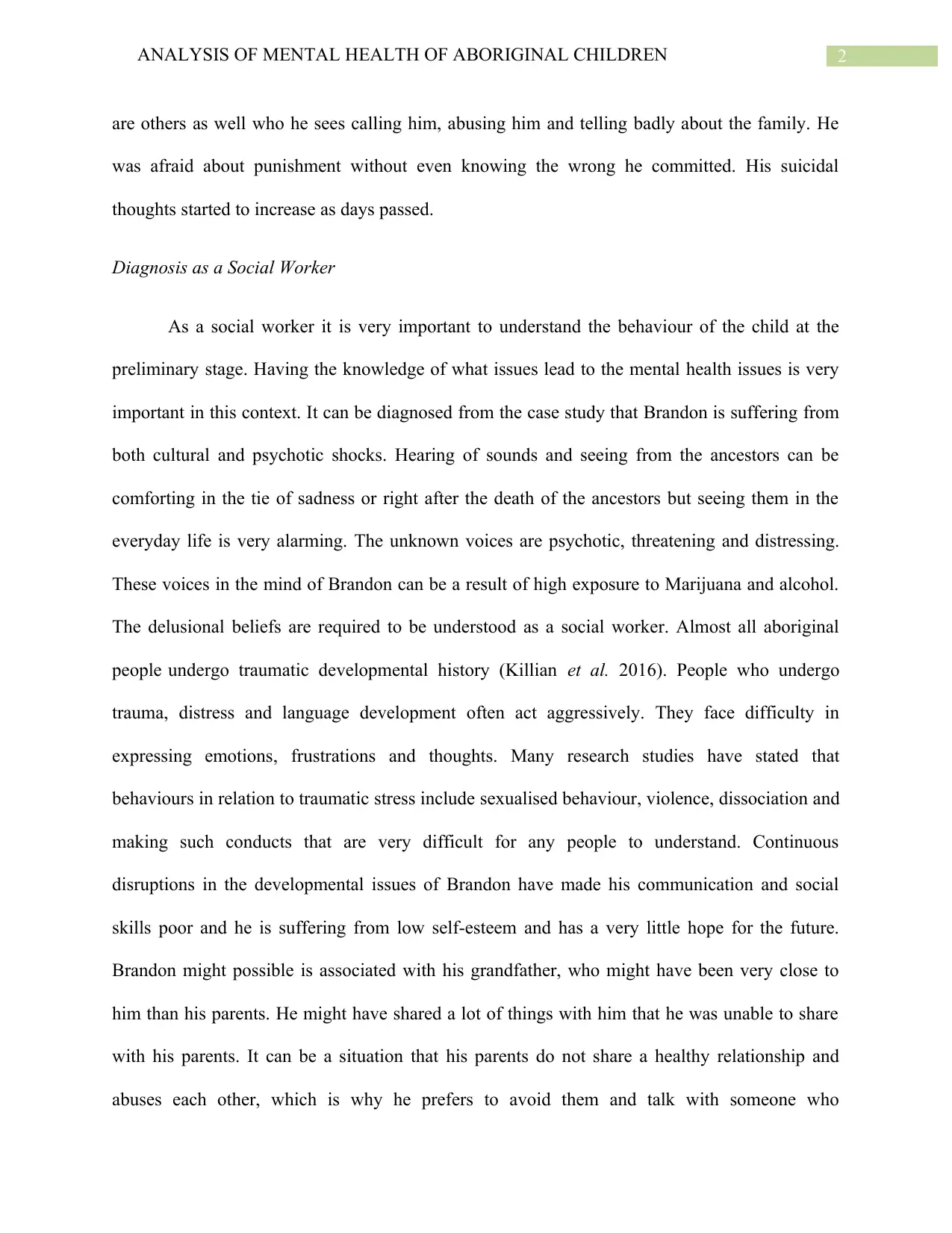
2ANALYSIS OF MENTAL HEALTH OF ABORIGINAL CHILDREN
are others as well who he sees calling him, abusing him and telling badly about the family. He
was afraid about punishment without even knowing the wrong he committed. His suicidal
thoughts started to increase as days passed.
Diagnosis as a Social Worker
As a social worker it is very important to understand the behaviour of the child at the
preliminary stage. Having the knowledge of what issues lead to the mental health issues is very
important in this context. It can be diagnosed from the case study that Brandon is suffering from
both cultural and psychotic shocks. Hearing of sounds and seeing from the ancestors can be
comforting in the tie of sadness or right after the death of the ancestors but seeing them in the
everyday life is very alarming. The unknown voices are psychotic, threatening and distressing.
These voices in the mind of Brandon can be a result of high exposure to Marijuana and alcohol.
The delusional beliefs are required to be understood as a social worker. Almost all aboriginal
people undergo traumatic developmental history (Killian et al. 2016). People who undergo
trauma, distress and language development often act aggressively. They face difficulty in
expressing emotions, frustrations and thoughts. Many research studies have stated that
behaviours in relation to traumatic stress include sexualised behaviour, violence, dissociation and
making such conducts that are very difficult for any people to understand. Continuous
disruptions in the developmental issues of Brandon have made his communication and social
skills poor and he is suffering from low self-esteem and has a very little hope for the future.
Brandon might possible is associated with his grandfather, who might have been very close to
him than his parents. He might have shared a lot of things with him that he was unable to share
with his parents. It can be a situation that his parents do not share a healthy relationship and
abuses each other, which is why he prefers to avoid them and talk with someone who
are others as well who he sees calling him, abusing him and telling badly about the family. He
was afraid about punishment without even knowing the wrong he committed. His suicidal
thoughts started to increase as days passed.
Diagnosis as a Social Worker
As a social worker it is very important to understand the behaviour of the child at the
preliminary stage. Having the knowledge of what issues lead to the mental health issues is very
important in this context. It can be diagnosed from the case study that Brandon is suffering from
both cultural and psychotic shocks. Hearing of sounds and seeing from the ancestors can be
comforting in the tie of sadness or right after the death of the ancestors but seeing them in the
everyday life is very alarming. The unknown voices are psychotic, threatening and distressing.
These voices in the mind of Brandon can be a result of high exposure to Marijuana and alcohol.
The delusional beliefs are required to be understood as a social worker. Almost all aboriginal
people undergo traumatic developmental history (Killian et al. 2016). People who undergo
trauma, distress and language development often act aggressively. They face difficulty in
expressing emotions, frustrations and thoughts. Many research studies have stated that
behaviours in relation to traumatic stress include sexualised behaviour, violence, dissociation and
making such conducts that are very difficult for any people to understand. Continuous
disruptions in the developmental issues of Brandon have made his communication and social
skills poor and he is suffering from low self-esteem and has a very little hope for the future.
Brandon might possible is associated with his grandfather, who might have been very close to
him than his parents. He might have shared a lot of things with him that he was unable to share
with his parents. It can be a situation that his parents do not share a healthy relationship and
abuses each other, which is why he prefers to avoid them and talk with someone who
⊘ This is a preview!⊘
Do you want full access?
Subscribe today to unlock all pages.

Trusted by 1+ million students worldwide
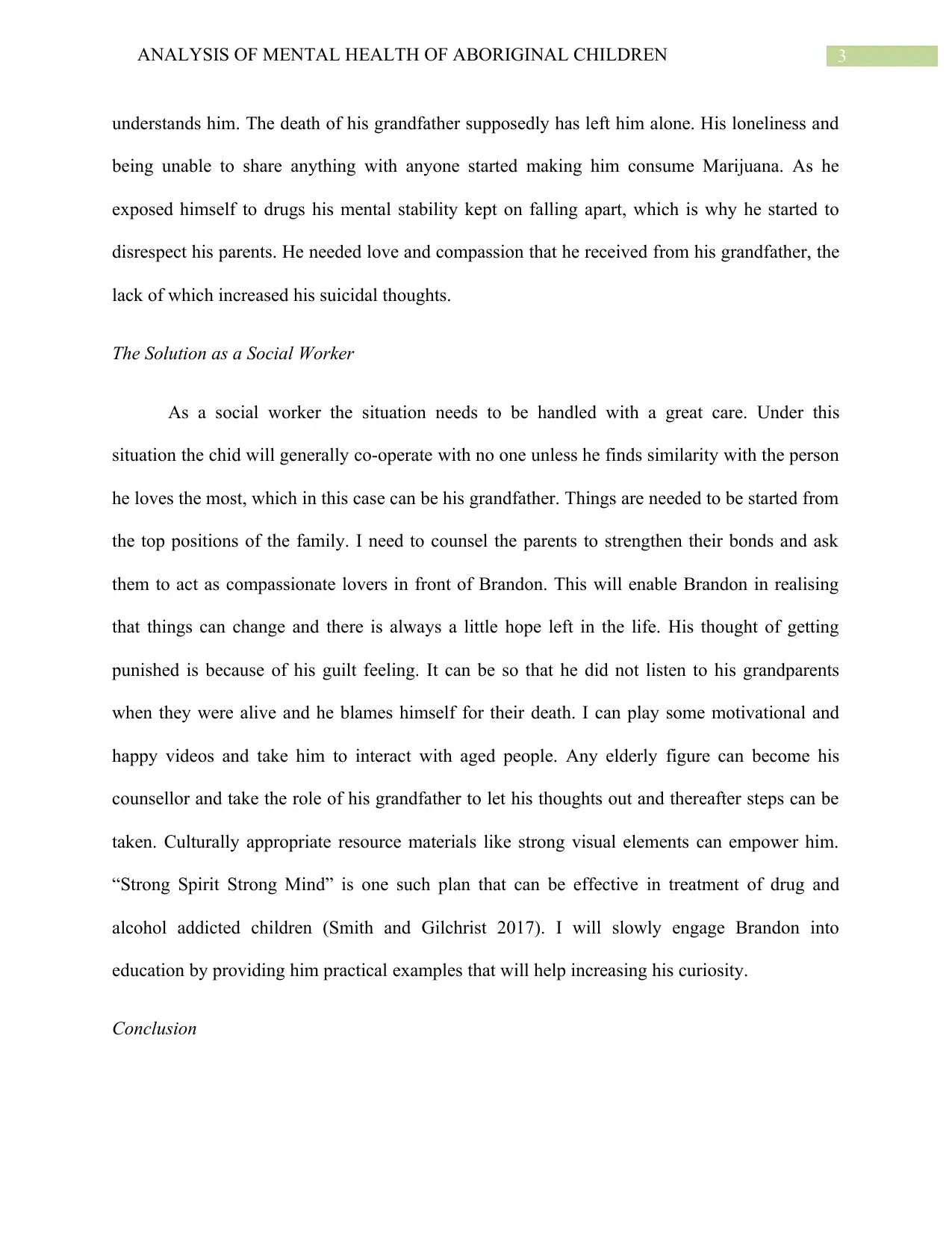
3ANALYSIS OF MENTAL HEALTH OF ABORIGINAL CHILDREN
understands him. The death of his grandfather supposedly has left him alone. His loneliness and
being unable to share anything with anyone started making him consume Marijuana. As he
exposed himself to drugs his mental stability kept on falling apart, which is why he started to
disrespect his parents. He needed love and compassion that he received from his grandfather, the
lack of which increased his suicidal thoughts.
The Solution as a Social Worker
As a social worker the situation needs to be handled with a great care. Under this
situation the chid will generally co-operate with no one unless he finds similarity with the person
he loves the most, which in this case can be his grandfather. Things are needed to be started from
the top positions of the family. I need to counsel the parents to strengthen their bonds and ask
them to act as compassionate lovers in front of Brandon. This will enable Brandon in realising
that things can change and there is always a little hope left in the life. His thought of getting
punished is because of his guilt feeling. It can be so that he did not listen to his grandparents
when they were alive and he blames himself for their death. I can play some motivational and
happy videos and take him to interact with aged people. Any elderly figure can become his
counsellor and take the role of his grandfather to let his thoughts out and thereafter steps can be
taken. Culturally appropriate resource materials like strong visual elements can empower him.
“Strong Spirit Strong Mind” is one such plan that can be effective in treatment of drug and
alcohol addicted children (Smith and Gilchrist 2017). I will slowly engage Brandon into
education by providing him practical examples that will help increasing his curiosity.
Conclusion
understands him. The death of his grandfather supposedly has left him alone. His loneliness and
being unable to share anything with anyone started making him consume Marijuana. As he
exposed himself to drugs his mental stability kept on falling apart, which is why he started to
disrespect his parents. He needed love and compassion that he received from his grandfather, the
lack of which increased his suicidal thoughts.
The Solution as a Social Worker
As a social worker the situation needs to be handled with a great care. Under this
situation the chid will generally co-operate with no one unless he finds similarity with the person
he loves the most, which in this case can be his grandfather. Things are needed to be started from
the top positions of the family. I need to counsel the parents to strengthen their bonds and ask
them to act as compassionate lovers in front of Brandon. This will enable Brandon in realising
that things can change and there is always a little hope left in the life. His thought of getting
punished is because of his guilt feeling. It can be so that he did not listen to his grandparents
when they were alive and he blames himself for their death. I can play some motivational and
happy videos and take him to interact with aged people. Any elderly figure can become his
counsellor and take the role of his grandfather to let his thoughts out and thereafter steps can be
taken. Culturally appropriate resource materials like strong visual elements can empower him.
“Strong Spirit Strong Mind” is one such plan that can be effective in treatment of drug and
alcohol addicted children (Smith and Gilchrist 2017). I will slowly engage Brandon into
education by providing him practical examples that will help increasing his curiosity.
Conclusion
Paraphrase This Document
Need a fresh take? Get an instant paraphrase of this document with our AI Paraphraser
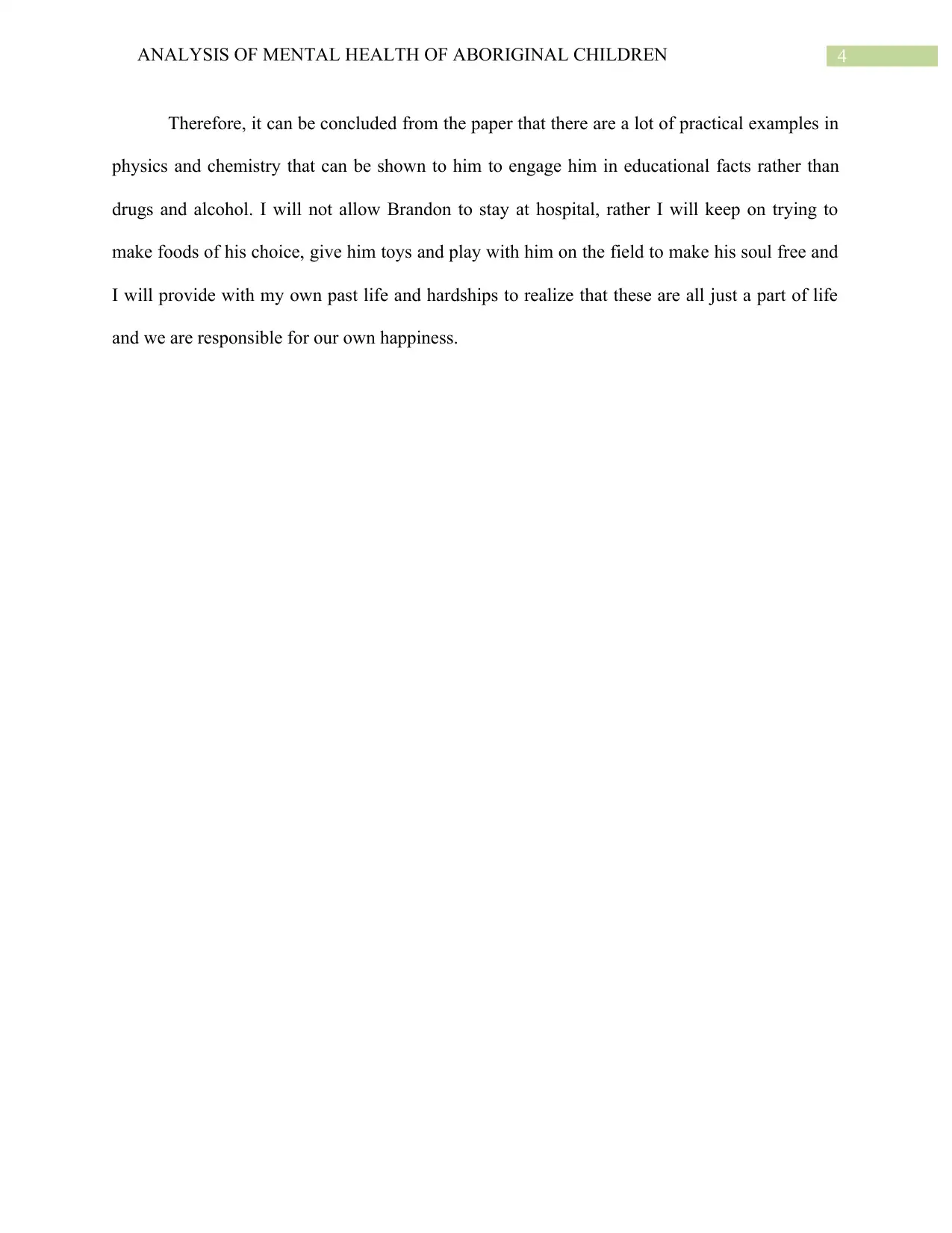
4ANALYSIS OF MENTAL HEALTH OF ABORIGINAL CHILDREN
Therefore, it can be concluded from the paper that there are a lot of practical examples in
physics and chemistry that can be shown to him to engage him in educational facts rather than
drugs and alcohol. I will not allow Brandon to stay at hospital, rather I will keep on trying to
make foods of his choice, give him toys and play with him on the field to make his soul free and
I will provide with my own past life and hardships to realize that these are all just a part of life
and we are responsible for our own happiness.
Therefore, it can be concluded from the paper that there are a lot of practical examples in
physics and chemistry that can be shown to him to engage him in educational facts rather than
drugs and alcohol. I will not allow Brandon to stay at hospital, rather I will keep on trying to
make foods of his choice, give him toys and play with him on the field to make his soul free and
I will provide with my own past life and hardships to realize that these are all just a part of life
and we are responsible for our own happiness.
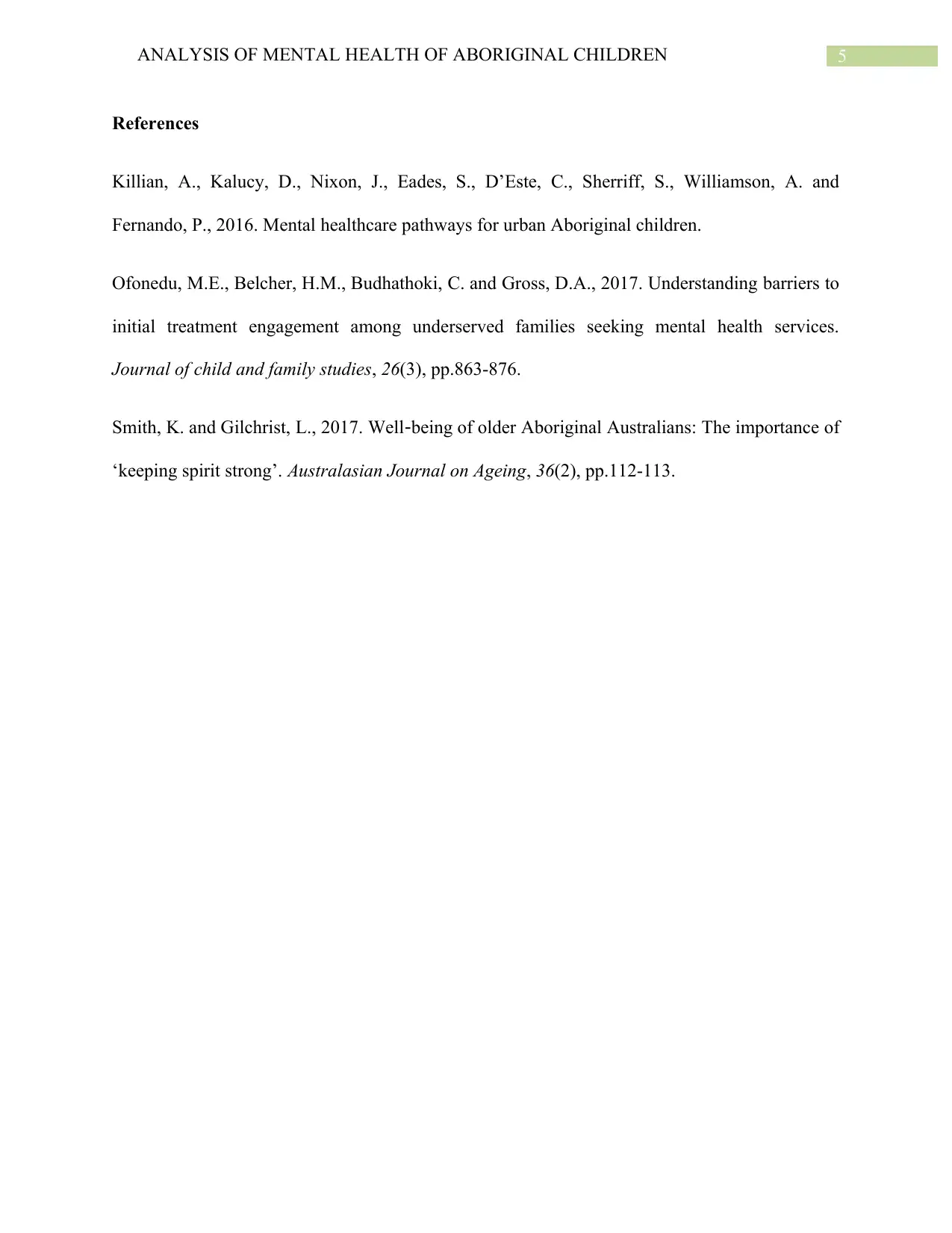
5ANALYSIS OF MENTAL HEALTH OF ABORIGINAL CHILDREN
References
Killian, A., Kalucy, D., Nixon, J., Eades, S., D’Este, C., Sherriff, S., Williamson, A. and
Fernando, P., 2016. Mental healthcare pathways for urban Aboriginal children.
Ofonedu, M.E., Belcher, H.M., Budhathoki, C. and Gross, D.A., 2017. Understanding barriers to
initial treatment engagement among underserved families seeking mental health services.
Journal of child and family studies, 26(3), pp.863-876.
Smith, K. and Gilchrist, L., 2017. Well‐being of older Aboriginal Australians: The importance of
‘keeping spirit strong’. Australasian Journal on Ageing, 36(2), pp.112-113.
References
Killian, A., Kalucy, D., Nixon, J., Eades, S., D’Este, C., Sherriff, S., Williamson, A. and
Fernando, P., 2016. Mental healthcare pathways for urban Aboriginal children.
Ofonedu, M.E., Belcher, H.M., Budhathoki, C. and Gross, D.A., 2017. Understanding barriers to
initial treatment engagement among underserved families seeking mental health services.
Journal of child and family studies, 26(3), pp.863-876.
Smith, K. and Gilchrist, L., 2017. Well‐being of older Aboriginal Australians: The importance of
‘keeping spirit strong’. Australasian Journal on Ageing, 36(2), pp.112-113.
⊘ This is a preview!⊘
Do you want full access?
Subscribe today to unlock all pages.

Trusted by 1+ million students worldwide
1 out of 6
Related Documents
Your All-in-One AI-Powered Toolkit for Academic Success.
+13062052269
info@desklib.com
Available 24*7 on WhatsApp / Email
![[object Object]](/_next/static/media/star-bottom.7253800d.svg)
Unlock your academic potential
Copyright © 2020–2025 A2Z Services. All Rights Reserved. Developed and managed by ZUCOL.





